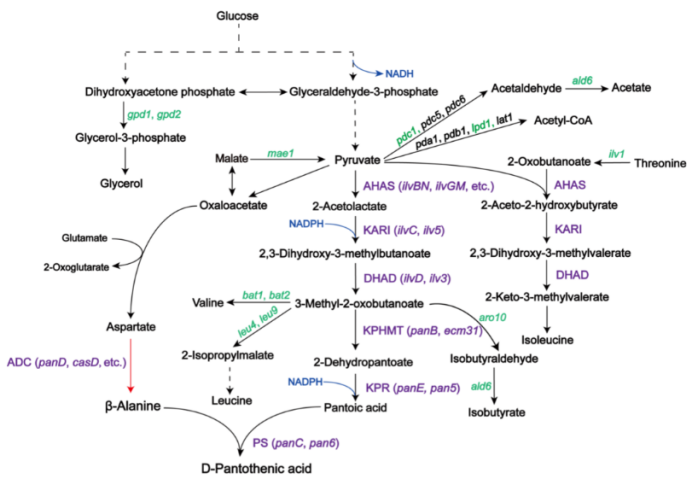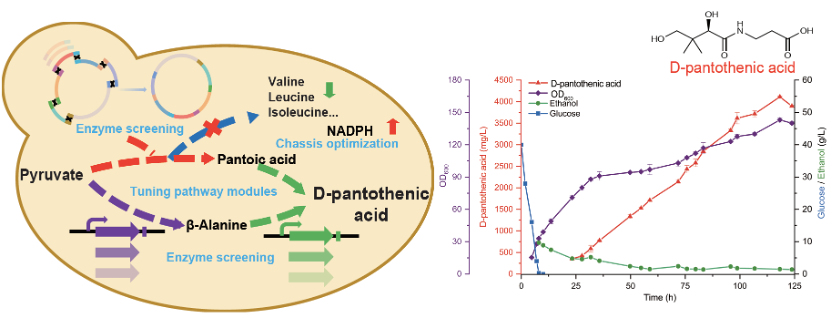
Vitamin B5 (also known as D-pantothenic acid) is involved in the metabolism of carbohydrates, fats, and proteins in cells. It is one of the essential vitamins for the human body and is widely used in fields such as medicine, feed, food, and health care. At present, D-pantothenic acid is mainly produced through chemical - enzymatic method, which involves the treatment of a large amount of cyanide-containing wastewater. As people attach importance to environmental protection, this method is faced with great challenges. Microbial cell factory, due to its green and environmentally friendly characteristics, is a breakthrough in realizing sustainable development of D-pantothenic acid production.

Screenshot of the published paper
Link of the paper: https://doi.org/10.1021/acs.jafc.3c01082
Professor Liu Tiangang of Wuhan University and associate researcher Ma Tian of Shenzhen Institute of Advanced Technology, Chinese Academy of Sciences, jointly published the research achievement in Journal of Agricultural and Food Chemistry under the title of “Metabolic Engineering of Saccharomyces cerevisiae for Vitamin B5 Production”. In this study, an efficient synthetic pathway of D-pantothenic acid was constructed in Saccharomyces cerevisiae and optimized through system metabolic engineering, and ultimately cheap medium was used without precursor, inducer, and antibiotic to synthesize 4.1 g/L D-pantothenic acid. It achieved the currently highest reported yield of D-pantothenic acid synthesized de novo from glucose in Saccharomyces cerevisiae.

Figure 1. The biosynthetic pathway of D-pantothenic acid involved in this study
Screening and adaptation of key enzymes in the synthetic pathway of D-pantothenic acid. In this study, the biosynthetic pathway of D-pantothenic acid was first designed into three modules: β-the alanine synthesis module, the D-pantoic acid synthesis module, and the condensation module of both, involving seven key enzymes (Figure 1). The functional enzymes from different species such as bacteria, yeast, fungi, algae, plants, animals, etc. were screened on a modular basis, and the best element adaptation combination was obtained through combinatorial screening. A heterologous synthetic pathway of D-pantothenic acid was constructed in Saccharomyces cerevisiae, and D-pantothenic acid was synthesized using a basic carbon source without precursor added.
Optimization of the biosynthetic pathway of D-pantothenic acid. To further strengthen the synthetic pathway of D-pantothenic acid, the author optimized the copy number of the genes of the three modules, and found that when the copy number of the D-pantoic acid synthesis module, β-alanine synthesis module, and precursor condensation module was 3:1:2, the engineering bacteria had the strongest ability to synthesize pantothenic acid.
On the other hand, there were several competing pathways in the synthesis of D-pantothenic acid. The author deleted or weakened different competing pathways around two key intermediate metabolites, namely pyruvic acid and ketoisovalerate. By knocking out the key genes of the competing pathways, the author identified four potential effective loci for D-pantothenic acid production increase, namely leu4, bat1, gpd1, and gpd2. Subsequently, the intracellular redox force was balanced by overexpression of pos5. Overexpression of mae1 increased the precursor pyruvic acid, and the high-yield strains of D-pantothenic acid were obtained.
Fermentation optimization of high-yield bacteria of D-pantothenic acid. In the above study, the expression of key genes was regulated by the galactose-inducible promoter. The author knocked out the key regulatory gene gal80, so that the overexpression of the gene was only regulated by glucose, and the engineering strain DPA171 was obtained. The fermentation conditions of strain DPA171 were optimized in the fermentor. By controlling the concentration of ethanol in the feeding stage to below 5 g/L, and without adding inducer, precursor, antibiotic, or other components, de novo synthesis of 4.1 g/L D-pantothenic acid was realized using glucose as carbon source.

Figure 2. High-yield of D-pantothenic acid in the Saccharomyces cerevisiae cell factory
In conclusion, in this study, a complete heterologous synthetic pathway of D-pantothenic acid was constructed in Saccharomyces cerevisiae for the first time, and system metabolic engineering was carried out to synthesize D-pantothenic acid de novo with glucose as carbon source, providing guidance for the construction of vitamin cell factories.
Guo Jiaxuan, a master degree candidate of Wuhan University, is the first author, and professor Liu Tiangang and associate researcher Ma Tian are the co-corresponding authors of the paper. This research work was supported by the National Key Research and Development Program and Wuhan Hesheng Technology Co., Ltd.
Introduction to the corresponding author:
Dr. Ma Tian is an associate researcher of Shenzhen Institute of Advanced Technology, Chinese Academy of Sciences. He is mainly committed to exploring the metabolic mechanism and engineering means of efficient microbial synthesis to achieve the green manufacturing of target biogenic drugs. He published his research achievements as the first author or corresponding author in Nature Communications, Metabolic Engineering, etc. His transformation achievements were awarded the 2018 Hubei Top 10 Science and Technology Events and the 2019 Hubei Provincial First Prize for Science and Technology Progress.
The research group is now recruiting postdoctoral fellows and research assistants in microbial green manufacturing. Priority is given to those with background in microbiology, biochemistry, and molecular biology. Interested comrades are welcome to send your resumes to tian.ma@siat.ac.cn.